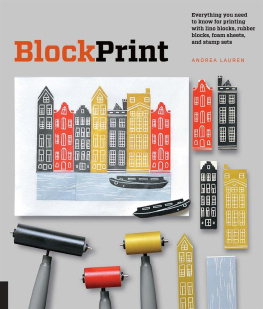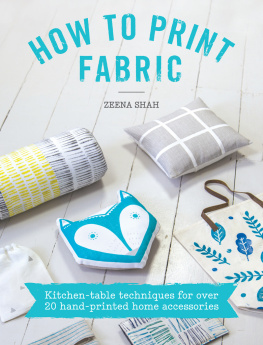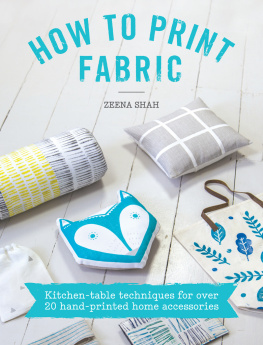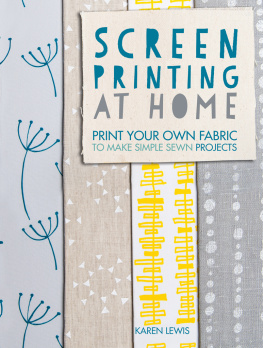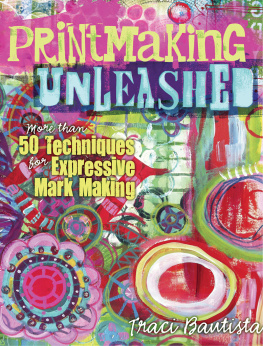Print & Stamp Lab
52 Ideas for Handmade, Upcycled Print Tools
Traci Bunkers

Contents






Introduction
THE AIM OF THIS BOOK is to share my excitement for what I call alternative printmaking. People of all skill levels, from unschooled to seasoned artists, can easily create unique and interesting prints with normal (and abnormal) objectsno fancy or expensive equipment is needed! Whether you want to make a simple greeting card or an elaborate piece of art, this will open your eyes to a new world where everyone is welcome. And the printmaking fixins are everywhere!
One of my super powers is that I can turn just about anything into an interesting stamp, printing block, or tool. (Im the female version of MacGyver when it comes to art making and art-making tools.) Ive had this skill since I was a kid, the product of a blue-collar family that was very practical, where making our own things was just what we did. Since we had limited resources, we figured out how to make do with what we had, or to use something else as a substitute. Thats when my skill for looking at things with a fresh eye for repurposing and reusing started.

This skill helps me tread lightly on this earth while doing what I love, which is making art. I dont create much waste because I always use my leftovers for something else, whether its collage material or a finished piece in itself. It also helps me to have an open mind and to work freely without worrying about or being tied to the outcome. For me, problem solving is a normal part of the art-making process, regardless of the media used. If something happens that I dont like, a creative fix usually results in something better than if I hadnt taken that interesting detour. This openness and fearlessness makes it possible for me to keep the juices flowing with new ideas, not only in my artwork, but also with new printmaking tools.
So step into my world and Ill teach you how to see overlooked, everyday objects in a new way, and how to turn them into easy-to-use printing blocks and tools. Why be restricted to only using commercial rubber stamps when you can make your own stamping and printing tools? Use them to enhance your artwork, clothing, furnishings, and paper goods, or to create a new piece of art. The various methods Ill cover range from very simple stamping to creating printing blocks and stamps from inexpensive materials. If you already have experience in stamping and printmaking, this book will expand your arsenal. Regardless of where you are on your artistic path, youll have fun making your own printing and stamping tools, and youll never be able to pass another hardware store, thrift store, garage sale, or dollar store again.
Many of the tools and projects featured here are created from thrift store or dollar store finds, or things found lying around the house. It isnt necessary to spend a lot of money, and for this reason, experimentation is encouraged. Reusing items breathes new life into them and is good for the planet and the pocketbook! Besides, the hunt is part of the fun, whether its for something to use as a printing tool or something to print on.

Overview
How to Use This Book
Print & Stamp Lab is made up of fifty-two labs organized into four different units. Each unit covers a different type of printing or stamping tool. The labs within the units progress from the easiest to make or use to the hardest, but its not necessary to work an easier lab in order to gain a particular skill for a harder lab. Also, the complexity of the tool has no bearing on how interesting its print is. Different tools can be used alone or together to make an endless variety of designs and prints.
Work through the book in any order you choose. Working with a friend, on the same lab or a different one, can be fun and add to the experience. Not only can you compare the results, but you can also feed off of one anothers energy and ideas. This can help you think of different combinations or materials that you might not have come up with on your own.
While making experimental prints, make notes either on the back of the print or in a separate book. Note which tools, paper, and paint or ink were used, along with any other helpful information, for example: I got a crisper stencil design when the brush was dry without much paint on it.
While making tools and prints from the book, set aside enough time to experiment. Try not to control the outcome, and just have fun. If you enjoy the experience and dont worry about the final product, youll have a much better time, and youll end up with better results.

Each lab has the same format, listing Materials, Instructions, and Tips. Under Materials is the supply list for making the tool or stamp for that lab. Instructions are the basic steps for how to make the tool and how to use it to make a print. Tips give some variations of materials or other things to try based on that particular lab. Each lab shows the materials, the finished stamp or tool, and three different prints: a simple print, a slightly more elaborate print using the same tool, and a complex print combining that tool with one or more tools from other labs. This will spark ideas for different ways to combine the tools.
At the very end of the labs is a gallery. It shows different projects, applications, combinations, and variations of everything that has been explored in the labs. Along with the photos is basic information. More information on the material used for the projects can be found on my website: www.tracibunkers.com. The gallery is meant to be an inspirational jumping-off point to show how everything you have learned can be put together and used artistically on just about any surface imaginable. The sky is the limit!
Okay, go have fun making tools from fun and funky stuff!

Basics




